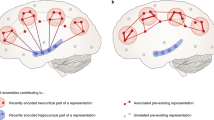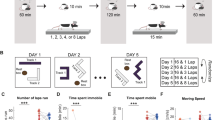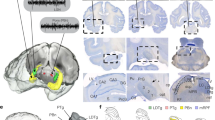Abstract
Sleep replay of awake experience in the cortex and hippocampus has been proposed to be involved in memory consolidation. However, whether temporally structured replay occurs in the cortex and whether the replay events in the two areas are related are unknown. Here we studied multicell spiking patterns in both the visual cortex and hippocampus during slow-wave sleep in rats. We found that spiking patterns not only in the cortex but also in the hippocampus were organized into frames, defined as periods of stepwise increase in neuronal population activity. The multicell firing sequences evoked by awake experience were replayed during these frames in both regions. Furthermore, replay events in the sensory cortex and hippocampus were coordinated to reflect the same experience. These results imply simultaneous reactivation of coherent memory traces in the cortex and hippocampus during sleep that may contribute to or reflect the result of the memory consolidation process.
This is a preview of subscription content, access via your institution
Access options
Subscribe to this journal
Receive 12 print issues and online access
$209.00 per year
only $17.42 per issue
Buy this article
- Purchase on Springer Link
- Instant access to full article PDF
Prices may be subject to local taxes which are calculated during checkout







Similar content being viewed by others
References
Squire, L.R. Memory and the hippocampus: a synthesis from findings with rats, monkeys, and humans. Psychol. Rev. 99, 195–231 (1992).
Fortin, N.J., Agster, K.L. & Eichenbaum, H.B. Critical role of the hippocampus in memory for sequence of events. Nat. Neurosci. 5, 458–462 (2002).
Squire, L.R., Stark, C.E. & Clark, R.E. The medial temporal lobe. Annu. Rev. Neurosci. 27, 279–306 (2004).
Hasselmo, M.E. & McClelland, J.L. Neural models of memory. Curr. Opin. Neurobiol. 9, 184–188 (1999).
Alvarez, P. & Squire, L.R. Memory consolidation and the medial temporal lobe: a simple network model. Proc. Natl. Acad. Sci. USA 91, 7041–7045 (1994).
Káli, S. & Dayan, P. Off-line replay maintains declarative memories in a model of hippocampal-neocortical interactions. Nat. Neurosci. 7, 286–294 (2004).
Siapas, A.G. & Wilson, M.A. Coordinated interactions between hippocampal ripples and cortical spindles during slow-wave sleep. Neuron 21, 1123–1128 (1998).
Sirota, A., Csicsvari, J., Buhl, D. & Buzsáki, G. Communication between neocortex and hippocampus during sleep in rodents. Proc. Natl. Acad. Sci. USA 100, 2065–2069 (2003).
Battaglia, F.P., Sutherland, G.R. & McNaughton, B.L. Hippocampal sharp wave bursts coincide with neocortical up-state transitions. Learn. Mem. 11, 697–704 (2004).
Mölle, M., Yeshenko, O., Marshall, L., Sara, S.J. & Born, J. Hippocampal sharp wave-ripples linked to slow oscillations in rat slow-wave sleep. J. Neurophysiol. 96, 62–70 (2006).
Wolansky, T., Clement, E.A., Peters, S.R., Palczak, M.A. & Dickson, C.T. Hippocampal slow oscillation: a novel EEG state and its coordination with ongoing neocortical activity. J. Neurosci. 26, 6213–6229 (2006).
Wilson, M.A. & McNaughton, B.L. Reactivation of hippocampal ensemble memories during sleep. Science 265, 676–679 (1994).
Skaggs, W.E. & McNaughton, B.L. Replay of neuronal firing sequences in rat hippocampus during sleep following spatial experience. Science 271, 1870–1873 (1996).
Kudrimoti, H.S., Barnes, C.A. & McNaughton, B.L. Reactivation of hippocampal cell assemblies: effects of behavioral state, experience, and EEG dynamics. J. Neurosci. 19, 4090–4101 (1999).
Hoffman, K.L. & McNaughton, B.L. Coordinated reactivation of distributed memory traces in primate neocortex. Science 297, 2070–2073 (2002).
Qin, Y.L., McNaughton, B.L., Skaggs, W.E. & Barnes, C.A. Memory reprocessing in corticocortical and hippocampocortical neuronal ensembles. Phil. Trans. R. Soc. Lond. B 352, 1525–1533 (1997).
Ribeiro, S. et al. Long-lasting novelty-induced neuronal reverberation during slow-wave sleep in multiple forebrain areas. PLoS Biol. 2, 24 (2004).
Eichenbaum, H., Dudchunko, P., Wood, E., Shapiro, M. & Tanila, H. The hippocampus, memory, and place cells: is it spatial memory or a memory space? Neuron 23, 209–226 (1999).
Jensen, O. & Lisman, J.E. Hippocampal sequence-encoding driven by a cortical multi-item working memory buffer. Trends Neurosci. 28, 67–72 (2005).
Nádasdy, Z., Hirase, H., Czurkó, A., Csicsvari, J. & Buzsáki, G. Replay and time compression of recurring spike sequences in the hippocampus. J. Neurosci. 19, 9497–9507 (1999).
Lee, A.K. & Wilson, M.A. Memory of sequential experience in the hippocampus during slow wave sleep. Neuron 36, 1183–1194 (2002).
Louie, K. & Wilson, M.A. Temporally structural replay of awake hippocampal ensemble activity during rapid eye movement sleep. Neuron 29, 145–156 (2001).
Cossart, R., Aronov, D. & Yuste, R. Attractor dynamics of network up states in the neocortex. Nature 423, 283–288 (2003).
Shu, Y., Hasenstaub, A. & McCormick, D.A. Turning on and off recurrent balanced cortical activity. Nature 423, 288–293 (2003).
Sanchez-Vives, M.V. & McCormick, D.A. Cellular and network mechanisms of rhythmic recurrent activity in neocortex. Nat. Neurosci. 3, 1027–1034 (2000).
Petersen, C.C., Hahn, T.T.G., Metha, M., Grinvald, A. & Sakmann, B. Interaction of sensory responses with spontaneous depolarization in layer 2/3 barrel cortex. Proc. Natl. Acad. Sci. USA 100, 13638–13643 (2003).
Volgushev, M., Chauvette, S., Mukovski, M. & Timofeev, I. Precise long-range synchronization of activity and silence in neocortical neurons during slow-wave sleep. J. Neurosci. 26, 5665–5672 (2006).
Amzica, F. & Steriade, M. Cellular substrates and laminar profile of sleep K-complex. Neuroscience 82, 671–686 (1998).
Steriade, M., Timofeev, I. & Grenier, F. Natural waking and sleep states: a view from inside neocortical neurons. J. Neurophysiol. 85, 1969–1985 (2001).
Csicsvari, J., Hirase, H., Mamiya, A. & Buzsáki, G. Ensemble patterns of hippocampal CA3-CA1 neurons during sharp wave-associated population events. Neuron 28, 585–594 (2000).
O'Keefe, J. & Dostrovsky, J. The hippocampus as a spatial map: preliminary evidence from unit activity in the freely-moving rat. Brain Res. 34, 171–175 (1971).
Hafting, T., Fyhn, M., Molden, S., Moser, M.B. & Moser, E.I. Microstructure of a spatial map in the entorhinal cortex. Nature 436, 801–806 (2005).
Hargreaves, E.L., Rao, G., Lee, I. & Knierim, J.J. Major dissociation between medial and lateral entorhinal input to dorsal hippocampus. Science 308, 1792–1794 (2005).
Lee, A.K. & Wilson, M.A. A combinatorial method for analyzing sequential firing patterns involving an arbitrary number of neurons based on relative time order. J. Neurophysiol. 92, 2555–2573 (2004).
Steriade, M., Nubez, A. & Amzica, F. A novel slow (<1 Hz) oscillation of neocortical neurons in vivo: depolarizing and hyperpolarizing components. J. Neurosci. 13, 3252–3265 (1993).
Steriade, M. & Amzica, F. Slow sleep oscillation, rhythmic K-complexes, and their paroxysmal developments. J. Sleep Res. 7 (suppl. 1): 30–35 (1998).
Achermann, P. & Borbely, A.A. Low-frequency (<1 Hz) oscillations in the human sleep EEG. Neuroscience 81, 213–222 (1997).
Hahn, T.T.G., Sakmann, B. & Mehta, M.R. Phase-locking of hippocampal interneurons' membrane potential to neocortical up-down states. Nat. Neurosci. 9, 1359–1361 (2006).
Kosslyn, S.M. et al. The role of area 17 in visual imagery: convergent evidence from PET and rTMS. Science 284, 167–170 (1999).
Wheeler, M.E., Petersen, S.E. & Buckner, R.L. Memory's echo: vivid remembering reactivates sensory-specific cortex. Proc. Natl. Acad. Sci. USA 97, 11125–11129 (2000).
Harris, J.A., Petersen, R.S. & Diamond, M.E. The cortical distribution of sensory memories. Neuron 30, 315–318 (2001).
Suzuki, W.A. Encoding new episodes and making them stick. Neuron 50, 19–21 (2006).
McClelland, J.L. & Goddard, N.H. Considerations arising from a complementary learning systems perspective on hippocampus and neocortex. Hippocampus 6, 654–665 (1996).
O'Reilly, R.C. & Rudy, J.W. Computational principals of learning in the neocortex and hippocampus. Hippocampus 10, 389–397 (2000).
Lavenex, P. & Amaral, D.G. Hippocampal-neocortical interaction: a hierarchy of associativity. Hippocampus 10, 420–430 (2000).
Rolls, E.T. Hippocampal-cortical and cortico-cortical backprojections. Hippocampus 10, 380–388 (2000).
Paxinos, G. & Watson, C. The Rat Brain in Stereotaxic Coordinates 4th edn. (Academic, New York, 1998).
Robert, C., Guilpin, C. & Limoge, A. Automated sleep staging systems in rats. J. Neurosci. Methods 88, 111–122 (1999).
Siapas, A.G., Lubenov, E.V. & Wilson, M.A. Prefrontal phase locking to hippocampal theta oscillations. Neuron 46, 141–145 (2005).
Skaggs, W.E., McNaughton, B.L., Gothard, K.M. & Markus, E.J. An information-theoretic approach to deciphering the hippocampal code. In Advances in Neural Information Processing Systems Vol. 5 (eds. Hanson, S.J., Cowan, J.D. & Giles, C.J.) 1030–1037 (Morgan Kaufmann, San Mateo, California, USA, 1993).
Acknowledgements
We thank E. Miller, C. Moore, J. Fisher and F.-M. Zhou for critical readings on the manuscript, and Wilson laboratory members for technical help and suggestions and comments on the project and manuscript. Supported by grants to M.A.W. from the Brain Science Institute at the Institute of Physical and Chemical Research (RIKEN) in Japan and the US National Institutes of Health.
Author information
Authors and Affiliations
Corresponding authors
Ethics declarations
Competing interests
The authors declare no competing financial interests.
Supplementary information
Supplementary Fig. 1
Hippocampal frames were related to hippocampal EEG ripples. (PDF 212 kb)
Supplementary Fig. 2
Temporal relationship between cortical and hippocampal frames was not significantly different between PRE and POST, and was not sensitive to frame definition parameters. (PDF 85 kb)
Supplementary Fig. 3
Cell pairs between the visual cortex and hippocampus that had high correlation during RUN also had high correlation in POST, but not in PRE. (PDF 28 kb)
Supplementary Fig. 4
High but not low correlation during RUN boosted correlation in POST between the visual cortex and hippocampus, and within the hippocampus. (PDF 78 kb)
Supplementary Fig. 5
Firing patterns in the visual cortex and hippocampus during RUN were replayed in sleep frames during POST. (PDF 36 kb)
Supplementary Fig. 6
Frame replays were compressed during sleep. (PDF 85 kb)
Supplementary Fig. 7
Difference in frame properties did not significantly contribute to increase in replaying ratio from PRE to POST. (PDF 87 kb)
Supplementary Fig. 8
There were no significant differences in distribution of frame duration, within-frame multiunit firing rate per tetrode, and within frame active cell firing rate between replaying and non-replaying candidate frames in either the visual cortex or the hippocampus. (PDF 22 kb)
Supplementary Fig. 9
Shuffling procedure to determine significance (p value) of the overlapping replaying frame pairs. (PDF 65 kb)
Supplementary Fig. 10
Temporal relationship between cortical and hippocampal sequence replays. (PDF 69 kb)
Supplementary Fig. 11
Sleep stage classification. (PDF 38 kb)
Supplementary Fig. 12
Frame boundary determination. (PDF 69 kb)
Supplementary Table 1
Minimum matching indices (I) required for significant frame sequences, given the number of cells in a frame. (PDF 26 kb)
Supplementary Table 2
Comparison in replaying frame ratio between PRE and POST in the visual cortex for each of the 12 trajectories. (PDF 19 kb)
Supplementary Table 3
Comparison in replaying frame ratio between PRE and POST in the hippocampus for each of the 15 trajectories. (PDF 19 kb)
Rights and permissions
About this article
Cite this article
Ji, D., Wilson, M. Coordinated memory replay in the visual cortex and hippocampus during sleep. Nat Neurosci 10, 100–107 (2007). https://doi.org/10.1038/nn1825
Received:
Accepted:
Published:
Issue Date:
DOI: https://doi.org/10.1038/nn1825
This article is cited by
-
The generative grammar of the brain: a critique of internally generated representations
Nature Reviews Neuroscience (2024)
-
A perspective on neuroethology: what the past teaches us about the future of neuroethology
Journal of Comparative Physiology A (2024)
-
No difference between using short and long intervals for distributed proficiency-based laparoscopy simulator training: a randomized trial
Surgical Endoscopy (2024)
-
Wake-like skin patterning and neural activity during octopus sleep
Nature (2023)
-
Interactions between rodent visual and spatial systems during navigation
Nature Reviews Neuroscience (2023)



